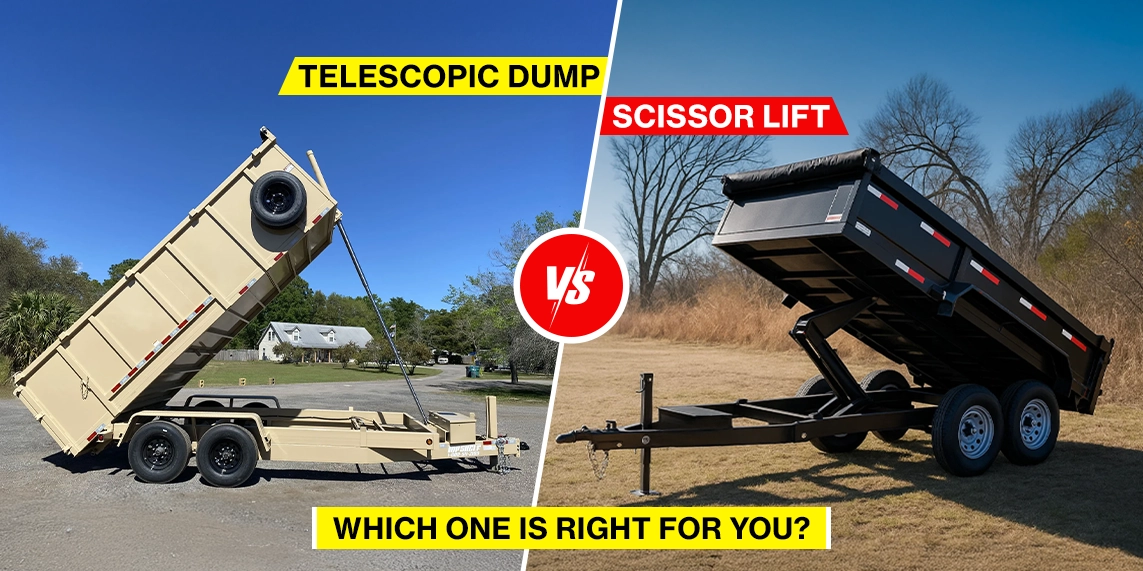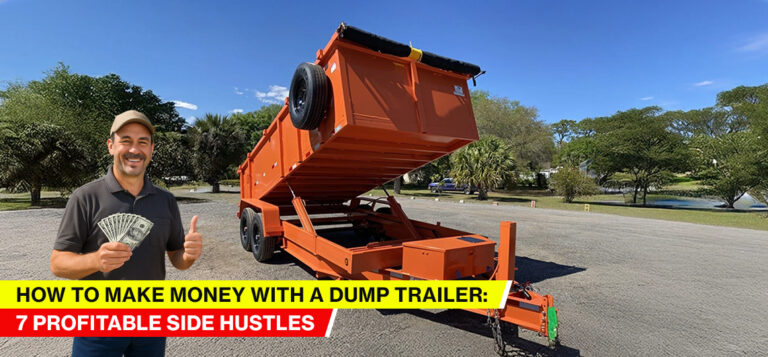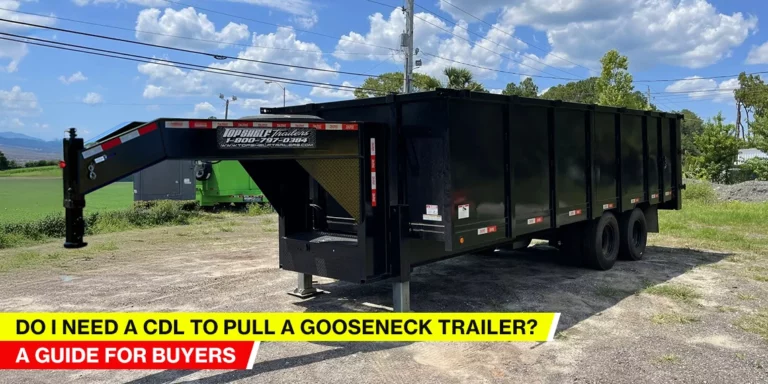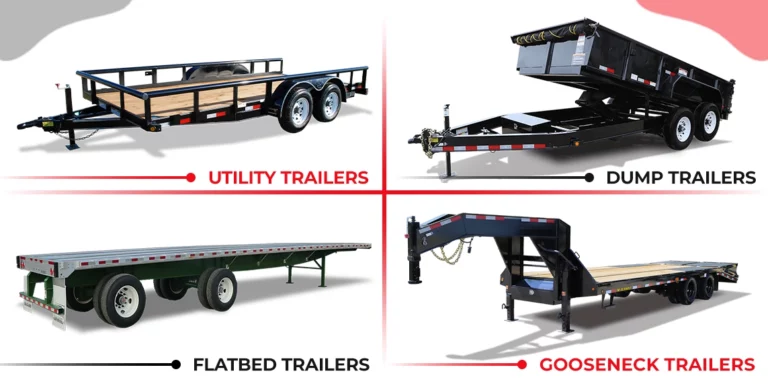Have you ever considered adding a lift system to your dump trailer? If not, let us convince you for the right reasons.
Trailer lifts are fine mechanisms that help hoist heavy loads off the trailer deck. They are available in multiple versions, from hydraulic to axles, and minimize the use of cranes.
However, which type of trailer lift system is ideal for your needs?
Choosing the right hauling equipment will significantly impact efficiency and profitability. When transporting bulk materials like gravel, sand, or construction debris, two of the most popular options often come to the forefront: the scissor lift dump trailer and the telescopic dump trailer.
Both offer unique advantages and disadvantages. Therefore, deciding the best trailer lift for your needs can be daunting.
In this blog, let’s explore who wins the scissor lift vs telescopic dump trailer debate. We will dissect these two powerful workhorses and delve into their functionalities, differences in design, and capabilities.
So, let’s discover which of these heavy-duty haulers—the scissor lift or the telescopic—is the right fit for your trailer.
Scissor Lift vs. Telescopic Dump Trailer – The Complete Breakdown
A thorough comparison is essential before we make a decision. However, first, the basics must be sorted.
What Is A Dump Trailer Lift System?
A dump trailer lift system is a simple mechanism that helps you raise the trailer bed and unload the materials. A few options are available: single—and dual-cylinder lifts, telescopic lifts, and the scissor lift. Remember, all dump trailers have a lift system; it all depends on your specific hauling needs.
Each has unique capacities and offers robust performances across varied terrains. However, today’s comparison window is for scissor lift vs telescopic dump trailer. Each is designed for specific needs, and your usability matters.
While scissor lifts are known for their robustness and reliability, a telescopic one is more versatile and offers speed.
It all comes down to your specific hauling needs. Let’s have a little breakdown –
What is a Scissor Lift?
The dump trailer scissor hoist is a robust and reliable lift system. It is known for its strong and stable vertical lifting mechanism.
Unlike other dump trailer designs, the scissor lift relies on a series of interconnected, X-shaped supports that resemble a pair of giant scissors. (Hence, the name)
A powerful hydraulic cylinder strategically positioned acts as the driving force behind the lift. When hydraulic pressure is applied, these “scissors” expand vertically, pushing the trailer bed upwards from its rear pivot point.
This process allows for the controlled and efficient discharge of its contents.
The number of scissor stacks can vary depending on the trailer’s intended payload capacity and dumping angle. Trailers designed for heavier loads and higher lifts often feature multiple, robust scissors for elevated stability and lifting power.
Benefits of Scissor Lifts: Stability, Power, and Simplicity
There are multiple compelling advantages of Scissor lifts that make them a preferred choice among trailer users –
1. Exceptional Stability
The most significant benefit of the scissor lift design is its inherent stability. The wide stance of the scissor arms provides a solid and balanced platform and minimizes the risk of tipping.
2. Powerful Lifting Capacity
The vertical thrust generated by the hydraulic cylinder and the leverage provided by the scissor arms translate to the lifting power. It can efficiently handle substantial payloads of dense materials.
3. Relatively Simple and Robust Design
Scissor lift mechanisms are generally considered simpler in construction. They are lower maintenance and offer increased durability over the long term. There are fewer moving parts and potential points of failure.
4. Efficient Unloading on Uneven Ground
The stable lifting allows for more controlled and safer unloading, even on slightly uneven surfaces. The mechanism has a significant advantage in dynamic job site environments.
5. Good Dumping Angle
Scissor lifts can achieve a steep dumping angle, ensuring a clean and complete discharge of materials. This reduces the need for manual shoveling or repositioning.
6. Lower Initial Cost (in some cases)
Depending on the specific models and features, scissor lift trailers can sometimes have a lower initial purchase price.
7. Easier Maintenance Access
The scissor lift mechanism’s open design facilitates inspection, lubrication, and maintenance.
While scissor lift dump trailers offer numerous benefits, it’s crucial to acknowledge their potential limitations –
- Due to the nature of the scissor mechanism, the pivot point for the trailer bed is typically higher. This can result in a slightly higher overall trailer height and overhead clearances.
- The extended scissor arms sometimes present a potential obstruction around the rear of the trailer during the dumping process.
- While powerful, the unloading speed of a scissor lift is slightly slower.
- The outward extension of the scissor arms increases the trailer’s overall footprint, which must be considered when working in confined spaces.
- While stable, improper loading affects the balance of a scissor lift trailer during dumping. Ensure a balanced load distribution for safe operation.
These considerations and advantages enable you to make a well-informed decision. Understand your towing and dumping needs before investing in a lift system.
What is a Telescopic Lift?
The telescopic dump trailer hoist relies on different lifting mechanisms. To be precise, it has a telescopic hoist.
This system utilizes one or more cylindrical tubes that fit snugly within each other, like a collapsing telescope. When hydraulic pressure is applied, these sections extend linearly. This pushes the front of the trailer bed upwards from its rear hinge point and rapidly discharges materials.
Telescopic hoists are renowned for their compact design and ability to achieve significant lift heights.
The number of stages in a telescopic cylinder varies, typically from three to five or even more, depending on the desired lift height and the trailer’s design.
Advantages of Telescopic Lifts: Speed, Compactness, and Versatility
Telescopic lift dump trailers offer a distinct set of advantages and are a preferred choice for specific hauling needs –
1. Faster Unloading Speed
Telescopic hoists have the potential for rapid extension. The direct linear movement of the cylinders often results in a quick rise of the trailer bed and a faster discharge of materials.
2. Lower Profile When Retracted
A telescopic cylinder’s nested design allows for a significantly lower overall height. This contributes to a lower center of gravity and enhances stability on the road.
3. Good Dumping Angle
Telescopic hoists can achieve a steep dumping angle with a relatively lower lift point on the chassis. This can be beneficial for stability during the initial stages of lifting.
4. Less Obstruction at the Rear
The telescopic cylinder is mounted centrally beneath the trailer bed. This results in less potential obstruction at the rear during the dumping process.
5. Versatility in Design
Telescopic hoists can be adapted to various trailer lengths and configurations, offering flexibility in trailer design and application.
6. Efficient for Certain Materials
The quicker, more direct lift is effective for unloading sticky or cohesive materials. The momentum generated by the faster tipping aids in a cleaner discharge.
Despite their advantages, telescopic lift dump trailers also have specific considerations worth keeping in mind:
- The single or sometimes dual centrally mounted telescopic cylinder offers less inherent lateral stability during lifting. Operating on uneven terrain requires greater caution.
- Telescopic cylinders are generally more complex in construction. Hence, the maintenance requirements are higher.
- The initial purchase price is comparatively higher depending on the number of stages and the overall capacity.
- Telescopic cylinders are primarily designed for linear vertical force. Excessive side loads or uneven weight distribution put undue stress on the cylinder seals and components.
- If the cylinders are not adequately lubricated or debris enters the system, the internal sliding surfaces may be bound or damaged, requiring costly repairs.
Understanding these considerations is crucial for determining if the speed and lower profile are what you need most. Remember, they are a valuable asset in hauling operations, and proper maintenance is essential.
Scissor Lift vs Telescopic Dump Trailer: Key Factors to Consider
Whether you need a scissor lift or a telescopic dump trailer depends on your needs. Each type performs uniquely across several crucial factors.
Let’s break down these key considerations to help you determine which trailer is ideal for your operational needs.
1. Stability
Scissor lift trailers generally boast superior stability during the unloading process. The wide stance of the extended scissor arms provides a broad and balanced base. They significantly reduce the risk of tipping, especially on uneven terrain.
The inherent stability offers greater operator confidence and enhances safety. The distribution of lifting force contributes to a more secure and controlled elevation of the trailer bed.
Telescopic lift trailers typically have single or dual centrally mounted cylinders. They can be more susceptible to instability during lifting, particularly on uneven ground.
While modern telescopic hoists are designed with safety in mind, the narrower base requires more care during load distribution. Operators must be more vigilant about the terrain and ensure the load is evenly balanced to mitigate the risk of tipping.
2. Dump Angle
Scissor lift trailers can achieve a steep and effective dumping angle. The geometry allows the rear of the trailer bed to pivot high, facilitating a good flow of most materials. This steep angle results in a cleaner and more complete discharge, reducing the need for manual cleanup.
Telescopic lifts are also capable of achieving excellent dumping angles. The linear extension pushes the front of the bed upwards, creating a significant tilt. Depending on the specific design and number of stages, the final dump angle is slightly greater than that of a scissor lift.
3. Speed
The unloading speed of a scissor lift can be moderate. While powerful, the arc-like motion of the lifting arms takes slightly longer to reach the full dumping angle. However, the stability offered compensates for a marginal difference in speed.
Telescopic lifts generally offer a faster unloading cycle. This has a significant advantage in high-volume operations, minimizing cycle times and maximizing productivity.
4. Frame Stress
The scissor lift design distributes the lifting force across a wider area of the trailer frame. This potentially reduces localized stress points. The multiple support points of the scissor mechanism contribute to the overall structural integrity and longevity.
Telescopic lifts concentrate the lifting force along the central longitudinal axis of the trailer frame. The modern trailer frames are engineered to withstand this stress. However, the frame design around the telescopic hoist must be robust to handle the concentrated forces during extension and retraction.
5. Maintenance
A scissor lift mechanism’s relatively straightforward and open design makes maintenance and inspection easier. The components are generally accessible for lubrication, cleaning, and repairs. There are fewer moving parts, hence, fewer potential points of failure. However, the multiple pivot points in the scissor arms require regular lubrication.
Telescopic cylinders have more internal complexity, with multiple seals and sliding surfaces. Maintaining the hydraulic system and ensuring the cylinders are clean and properly lubricated is crucial. Due to their complex internal components, repairs can be more intricate and potentially more costly.
6. Load Suitability
Scissor lift trailers are well-suited for a wide range of bulk materials. It includes aggregates, construction debris, and general landscaping materials. Their stability and good dumping angle make them versatile for various applications.
Telescopic lift trailers are also versatile and can handle various materials. Their faster tipping action can be particularly advantageous for unloading sticky or cohesive materials.
It is vital to consider these factors when evaluating your specific hauling needs. The types of materials you transport, the terrain you operate on, and your budget are essential pointers. With thorough knowledge, you can decide between a scissor lift and a telescopic dump trailer for greater productivity.
Beyond the Hoist: Other Dump Trailer Features to Check
While the lifting mechanism – scissor or telescopic – is a primary differentiator, there are things beyond the hoist. Your investment’s overall performance, safety, and longevity hinge on many other critical features.
Overlooking these can lead to operational inefficiencies, safety hazards, and, ultimately, a costly mistake.
Let’s comprehend the essential aspects beyond the hoist that deserve your thorough consideration when choosing a dump trailer –
1. GVWR: Gross Vehicle Weight Rating
The Gross Vehicle Weight Rating (GVWR) is the maximum permissible total weight of the loaded trailer. This includes the weight of the trailer, the weight of the cargo, fluids, and any passengers or equipment carried within the trailer.
Understanding and adhering to the GVWR is paramount for safety and legal compliance. Exceeding the GVWR can lead to excessive wear and tear on the trailer’s components. It also compromises braking performance and potential fines or legal repercussions.
Always ensure the trailer’s GVWR is sufficient for your typical hauling needs and provides a comfortable margin for safety.
2. Payload and Size
Payload refers to the maximum weight of cargo the trailer is designed to carry. This is directly related to the GVWR and the trailer’s empty weight (tare weight).
Carefully assess the volume and density of the materials to determine the appropriate payload capacity. Similarly, the physical size of the trailer bed – its length, width, and height – dictates the volume of material it can transport.
Consider the space you need for hauling. Choosing a too-small trailer will lead to more trips, while one too-large might be cumbersome to maneuver.
3. Axles
The number and type of axles significantly impact a dump trailer’s stability, load capacity, and ride quality. The two most popular are the single and dual-axle ones.
Single-axle trailers generally suit lighter loads and shorter distances, offering better maneuverability.
Tandem or dual-axle trailers with two axles provide increased stability, better weight distribution, and a higher GVWR. Tridem-axle trailers with three axles offer even greater load-carrying capacity and improved weight distribution for heavy hauls.
Consider the typical weight of your loads and the terrain for the ideal axle configuration.
4. Brakes
Reliable and effective trailer brakes are non-negotiable. Dump trailers typically come equipped with electric brakes, air brakes, or a combination of both, depending on their GVWR and the towing vehicle’s capabilities.
Ensure the trailer’s braking system is compatible with your towing vehicle and meets all relevant safety regulations. Regular inspection and maintenance of the braking system are crucial for preventing accidents.
Features like breakaway systems are also essential safety considerations.
5. Build Quality
The overall build quality of a dump trailer directly impacts its durability, lifespan, and usability. Pay close attention to the materials used in construction, the quality of welds, and the robustness of the components.
Look for trailers constructed from high-strength steel with reinforced stress points. Features like powder coating or other durable finishes protect against rust and corrosion, extending the trailer’s life.
A well-built trailer will withstand demanding tasks, saving you time and money in the long run.
6. Hitch Type
The hitch connects the dump trailer to the towing vehicle. Selecting the correct hitch type is paramount, and security and compatibility are critical.
Common hitch types for dump trailers include ball hitches, pintle hitches, and gooseneck hitches. Ball hitches are typically used for lighter trailers, while pintle and gooseneck hitches are designed for heavier loads and offer a more secure connection.
The GVWR of your trailer and your vehicle’s towing capacity will dictate the appropriate hitch type. Ensure the hitch is correctly rated for the weight and is regularly inspected for wear and tear.
Investing in quality features upfront can save you significant costs and headaches. These are factors that matter and will contribute to your towing experience.
Which Hoist is Right for You? Matching the Hoist to Your Job
So, we have successfully navigated the scissor lift vs telescopic dump trailer debate. The mechanics and merits of both are thoroughly understandable.
The million-dollar question is – which hoist is the champion for your specific needs?
The answer is not black and white but a nuanced blend of your typical jobs, the materials you haul, and your work environments.
Let’s break down how to match the hoist to your hustle.
1. For the Stability Seeker
The scissor lift’s inherent stability is significant if your work frequently involves uneven terrain. It is ideal for construction sites with loose gravel, landscaping projects on slopes, or demolition sites with unpredictable surfaces.
The wide footprint during unloading provides a sure footing. The design minimizes the risk of tipping and allows you to operate with greater confidence and safety.
Furthermore, if your maintenance crew prefers a simpler, more accessible mechanism, the scissor lift’s straightforward design might be better.
A scissor lift’s powerful vertical thrust ensures efficient unloading for those hauling dense materials like gravel, sand, or broken concrete.
2. For the Speed Demon
The telescopic lift is perfect if your operation thrives on rapid turnaround times and you are constantly moving. Their speed advantage can be a game-changer.
Whether you are delivering multiple loads in a day or need to quickly clear debris from a busy site, a telescopic hoist significantly boosts your productivity.
This speed can also be particularly beneficial when dealing with materials sticking to the bed. The quicker, more forceful tipping action encourages a cleaner release.
The telescopic lift excels at hauling materials like mulch, topsoil, or lighter construction debris where speed is paramount.
Considering the Nitty-Gritty beyond Stability and Speed, Consider these Finer Points –
- Operating Environment: If you frequently work in tight spaces, the potentially wider footprint of a fully extended scissor lift might be a consideration. Telescopic lifts generally maintain a more compact overall footprint during operation.
- Load Type: While both can handle a variety of materials, extremely sticky loads might benefit from the faster, more forceful discharge of a telescopic lift.
- Maintenance Capabilities: Assess your in-house maintenance expertise. A scissor lift’s simpler design might be easier for your team to maintain.
- Budget: Initial purchase costs can vary between the two types. When making your decision, factor in long-term maintenance costs as well.
- Towing Vehicle: Ensure your towing vehicle is compatible with your chosen dump trailer’s weight and hitch requirements.
Premium Telescopic Lifts from Top Shelf Trailers
There is no universal answer to finding the ideal hoist for your dump trailer. It is a carefully considered decision based on your work’s unique demands.
It is essential to honestly evaluate your typical jobs, the materials you handle, and the conditions you work in. However, if speed and efficiency in a fast-paced environment are your top priorities, the telescopic lift is what you need.
You can confidently choose the best telescopic hydraulic cylinder for your dump trailer from Top Shelf Trailers. We are the top-rated manufacturer in the United States, offering varied trailer types and all the trailer essentials under the same roof.
When investing in a hoist mechanism, choose the one that serves your needs and drives your business forward. Do not just buy a trailer; invest in a solution that perfectly matches your hustle.




